A look at life in the 20th century
A project based on the friendship and work ethnic of
the people in a vibrant community in Ulster.
FOREWORD
The idea for this book was mooted on 17th
March 1998, the day Hillside Terrace, Culcavey, was demolished in
preparation for rebuilding. Whilst surveying the pile of rubble of what
had been a row of mill houses, two people reminisced on the lives of
those people who had occupied the houses, on stories of the area, and
realised how much was being lost and not recorded. This brought about an
article in the Ulster Star and a call for interested parties to meet and
put together information and photographs in order to retain a history of
the Culcavey, Halftown and Lower Maze area. The project was funded by
the Millennium Heritage Fund, to whom we are most deeply grateful. Mr
Bertie Emerson had over a number of years researched and compiled a
history of the area, and with his help and that of Thompson Crossey and
Tom Patterson the idea took shape and has culminated in this
publication.
Many people have helped in the preparation of this book. Local people
have gone out of their way to offer assistance in the search for
information and photographs. Thanks to everyone who contributed.
Thanks must also go to the following people for the contributions they
have made. Mr Peter Ward on the history of LOL 111 and Lower Maze
Scarlet Knights Black Perceptory No.124; Mr Ernie Cromie on Long Kesh
aerodrome; Mr David Adams on the Halftown area; Mr. Thomas Palmer on
family history; Mr. William Finn on the McCandless brothers; Mrs Norma
Higginson on Ogles Grove Farm; Mr Colin Fowler on Culcavey House; Mr CW
Bell on All Saints' Eglantine; Mr Harold McBride on war years in the
Halftown; Mr Herbert Bell and Mrs Annie McClenaghan on Culcavey Factory,
and Mr Derek Henderson and Mrs Barbara Lewers on Newport Primary School.
A special debt of gratitude is due to Mr Brian Mackey who allowed access
to photographs in the Lisburn Museum and kindly gave permission for a
number of them to be reproduced. The Public Record Office of Northern
Ireland also supplied the same service. Thanks also to the Ulster Star
for their help in publicising the search for information.
For his help, guidance and interest, we are deeply indebted to our
editor, Simon Walker, without whose help this book would not have been
possible.
It is inevitable that many stories are missing from this book, and no
doubt in many cupboards and drawers are photographs and documents which
could tell a fuller story. In the future it is hoped to create a museum
in Lower Maze Hall where all photographs included in this book will be
displayed plus the many more which have come to hand.
Pearl Finn & Jackie McQuillan

As It Was
If we were to take a dander down from
Hillsborough to Halftown, a distance of some 2 miles. I wonder how many
of us would notice what has changed over the years. So let's have a go.
We start the journey with the Millvale
Road on our left and what was Smith's garage on the right. Where the Gas
Works stood at the beginning of Millvale Road there now stands a block
of flats. Smith's garage is a motor bike shop. The first field on the
left now accommodates the houses of Hillcourt, whilst directly opposite
on the right the two semi-detached pebble-dashed houses are gone
replaced by red brick apartments. As we head towards the bottom of the
hill we find that on the left-hand side Hillsborough Nursery has gone,
now the Pines. Next to the Nursery was the 'sewage works', and here we
have Harwich Mews. To the right was the entrance to Hillsborough Railway
Station, the site now being a private dwelling. Under what was the
railway bridge, now the bridge accommodating the A1 dual carriageway, we
proceed towards the next small hill, locally known as McBride's Hill.
Before we stretch our legs to ascend the hill we look to the right to
where the lnkpot stood, and to the left the entrance to Culcavey Cottage
Farm (later renamed Culcavey House). Sadly both buildings are gone. When
we reach the brow of the hill Heatherbank Farm was on the lane to the
right. The house still stands, but the farm land around it has been
replaced by modern dwellings.
We proceed on down the road and spot the
entrance on the left to Mill Pond (known locally as the dam or McBride's
dam), a vital element in the power supply to Culcavey Factory in early
days. Here the Pond overflows into the Whiskey River that meanders right
through Culcavey village. Past the Mill Pond stood a two-storey house
and further on Mill Cottage with adjoining building known as the reading
room', all now gone and replaced by a palatial dwelling. Before we
descend the next small hill we look to the right where the large red
brick dwelling known as Ogles Grove House stood and the area around it
which was Bradshaw's Nursery. Both are now gone and where Ogles Grove
House stood we have expensive red brick dwellings. Starting to descend
the hill, if we look to the left where the leafy Culcavey Glen stood we
find once again red brick houses nestled below. If it is quiet we can
still hear the waterfall. At the bottom of the hill Ogles Grove Farm is
on the right, again no longer a working farm, but surrounded by houses.
To the left was the main entrance to Culcavey Factory (Hillsborough
Linen Co.). On entering the main gates on the right hand side stood a
small red brick house, and many will remember it as the residence of
Matt Spence. Adjoining this was a long factory building. All traces of
the factory, house and outbuildings have gone and the whole site is
built up with houses such as Old Mill and Old Mill Heights.
Still standing at the side entrance to
the factory is the old oak tree and where Ogle Terrace begins there were
two small one-storey houses known as Smithy Row. The next row of houses
(still part of Ogle Terrace) was English Row. This is the only row of
the original mill houses left. We pass the entrance to Grove Park, which
used to be an open area leading to the plots' (allotments) which
stretched the back of all the mill houses and were used to grow
vegetables, keep hens and even the odd pig or two. The next two houses
on the left and the shop used to be Shop Row, although there was no gap
between them. The shop is still the original building but the houses
comprising Shop Row have been replaced by Nos. 13 and 14 Ogle Terrace.
On the right-hand side, opposite the shop, was Rose Cottage � a gate
still marks its entrance but the fields are filled with houses.
We now proceed down the hill and on the
left Hillside Terrace (variously known as Grey Row, White Row,
Distillery Row) has been replaced with new red brick houses. At the
crossroads on the road to the left were Thompson's Row and Puddledock
Row. If we proceed over the crossroads, immediately on the right was a
small wooden structure where the children spent their pennies � `Dick's
hut', a small shop run for a long time by the late Mr. Dick Thompson.
Another part of the village missing.
On down the road on the left we have
Oakmount, the residence of the Emerson family. Immediately past their
house was a lane that led to a row of houses known as Railway View.
Something else gone. On the right-hand side was a small whitewashed
cottage, once occupied by the village cobbler. Next on the right is
Culcavey Mission Hall, somewhat changed over the years, but thankfully
still there. The road now diverges slightly, and here we have Newport
Primary School (the new school), the original road now runs down the
back of the school. If we look to the left behind the school we can see
the imposing structure of Newport House, virtually unchanged. On down
the road on the left was the entrance to the coal quays. Small houses
used to stand in this area, some just to the right-hand side as you
entered and some further on down the entrance to the left. The houses
are long gone, the coal quays are gone and more importantly the canal
has gone, replaced by the M 1 motorway. A new more expansive bridge now
replaces the old Newport Bridge that spanned the canal. Also disappeared
from the skyline is the viaduct that spanned the canal, and Newport
railway halt is no more. The road to the right known locally as the
`Dummies Loanin', is now Eglantine Road. Over the bridge we can look to
the left and see the old Newport School. The two roads on the right were
`Berry's Loanin' and `Sandy Lane', while on the left we had `Anthony's
Loanin' and `Moss Road'. Just names in memory now. At Coronation Gardens
we had the entrance to Long Kesh Aerodrome on the left and slightly
further down Lower Maze Orange Hall (now Lower Maze Community Hall).
Such changes: no aerodrome (turned into a prison), and now no prison.
Our next two roads past the defunct prison are Bog Road on the left and
Blaris Road on the right.
From railway, factory, canal and
aerodrome, and everything in between, who notices change?
Where did it all go? Can you remember
spending hours in the glen exploring; jumping across the Whiskey River
to see who could do the biggest jump; walking along the canal tow-path
on a Sunday afternoon; building houses and dens in the hedgerows along
`the plots'; swinging on rope around the lamp-posts; collecting jam jars
and bottles to get your pennies; making a `slide' down the middle of the
road on cold frosty nights; playing football between the gable walls of
Thompson and Puddledock rows; walking to the pictures in Ritchie's Hut
on a Monday night; the hours spent talking at `the corner'; carrying
water from the pump; cooking on the range; coats on the bed in winter;
the dry toilet at the bottom of the garden and `the bucket' under the
bed; `progging' an orchard; `purty hoking'; the tin bath in front of the
fire on a Saturday night; the mangle in the yard; the scrubbing board in
the `jaw-tub'; winding wool off a skein; knitting on four needles and
`turning a heel'; holes in the heels of your socks, and darning?
It seems hard to believe that Culcavey
people of a generation ago simply would not recognise their area.
Nothing remains static in this transitory world.

PLACE NAMES
So much has changed that many of the old
places and their names have now vanished or are unrecognisable. Another
generation or two and this knowledge could be lost forever. Each place,
by its very title, was able to impart something of its tale.
ANNACLOY The fort of the stones.
AUGNNATRISK This means the area of
the brewer's grains.
THE BASIN Near Kesh Bridge was the
'Basin', a large circular area of water three times the width of the
canal, which was the authorised spot for barges to change direction or
to stop and wait to allow oncoming barges to pass.
BLARIS Scottish word for a moor.
BRICKFIELD LODGE This house stood
on the site now occupied by the electricity depot on the Aughnatrisk
Road. Bricks were made from clay here during the seventeenth and
eighteenth centuries.
CULCAVEY The back of the hill of
the lush grass.
DISTILLERY ROW These began life as
sixteen single-storey houses given the name 'White Row' by the linen
company. After the First World War they were given an upper storey and a
coat of grey pebbledash. The company now called the terrace 'Grey Row',
although the directors called it 'Millionaires' Row' as the alterations
had been so costly! Young ladies living in the terrace did not like the
drab new name and so they christened it 'Hillside Terrace'. Although the
houses were demolished and replaced in 1999, thelatter name has been
retained.
EGLANTINE This is a French word
meaning sweet briar or wild rose. It gives its name to the Church of
Ireland parish of All Saints. The Eglantine Road was once known as the
'Dummies Loanin' as an individual who was unable to speak lived there.
ENGLISH ROW These were eight
two-storey houses. The Englishmen who installed machinery in the linen
factory lived here. This row was originally of red brick, but has been
renovated and is now part of Ogle Terrace. These were built by the linen
company.
HALFTOWN An English translation of
the French word Demiville.
HARRY'S ROAD In the nineteenth
century two brothers lived on this road who kept Harrier hounds for
hunting hares. As a consequence they were, by trade, 'harriers'. The
road was known as Harriers' Road until the brothers died and then the
road became known after the only person living on it, Harry McConville.
KESH BRIDGE This was a hump-backed
bridge and its design was suitable only for slow-moving vehicles.
LAGAN The word 'lagan' is
described as 'Cargo or equipment thrown into the sea from a
ship (in distress), often attached to a float or a buoy to enable it to
be recovered'.
NEWPORT BRIDGE Although there is
still a bridge bearing this name, this dates only from the construction
of the M I motorway. There
were three previous bridges, not on the same site, one of which was a
temporary iron bridge constructed by the army.
PUDDLEDOCK ROAD This led to Puddledock
Farm, where there were deposits of puddle (clay) which, when mixed with
water, made a crude form of cement used to line the walls and floors of
cottages. `Dock' referred to the place where this clay was obtained. The
road is now called the Aughnatrisk Road.
PUDDLEDOCK ROW Named after the road, these were two-storey houses
built by the Hillsborough Linen Company. The row was replaced by Hart
Terrace. SHOP ROW Four
two-storey houses, Culcavey Stores and a dwelling. Although the shop
still stands as a detached building, the other houses were replaced by
part of Ogle Terrace. Built by the Hillsborough Linen Company.
SMITHY ROW This was a one-storey structure � one end a forge, the
other a dwelling. In 1960 four two-storey houses replaced this row and
these are part of Ogle Terrace. `Ogle' is taken from nearby Ogles Grove.
THOMPSON'S ROW Ten two-storey houses named after the builder,
these were also built by the linen company.
 OLD CULCAVEY
- HISTORICAL FACTS Until about four hundred
years ago this little corner of county Down was largely uninhabited and
disregarded. When the Normans drove deep into the county in the twelfth
century they established centres of power at Duneight and Dromore. It
was thought that earthen castles or mottes built in those two places
would be sufficient to keep an eye on the residents of the intervening
land. As with most of Ulster until the seventeenth
century, this area would have been heavily wooded, most probably with
deciduous trees. Such means of communication or movement as existed
would have been closely associated with natural physical features such
as rivers or streams. Ulster, like the rest of Ireland, had for
centuries been under the control of the powerful Irish chieftains and
this area fell under the rule of the Magennes clan who lived in a large
`rath' or protected circular farmstead on the present site of
Hillsborough Fort. These clans were troublesome for the English Crown
which, by the sixteenth century, wanted to make Ireland easier to
govern. Under pressure from the Crown, many of the chieftains were
forced to flee from Ireland and the departure of key figures such as
O'Neill and McDonnell is known as the `Flight of the Earls'. With the
native rulers gone, King James I proceeded to implement a scheme to
colonise Ulster with loyal Protestant subjects from England and
Scotland. This grand scheme used the abandoned land of the Irish clans
and was called the Plantation of Ulster. Those who came to Ireland at
this time were called `Planters'. It was the king's
intention that the division of land should be in three tiers:
-
Approved English and Scottish settlers received
about 2,000 acres of land on condition that within three years it
was planted with the aid of forty-eight able-bodied men of their own
nationality. A castle and bawn (walled yard) had to be built to
secure and protect the residents and cattle.
-
Military officers and servitors (ex-servicemen) were
granted 1,500 acres on condition that within two years they built a
strong stone or brick house and bawn. They were permitted to take a
certain proportion of Irish tenants.
-
Native Irish of approved loyalty were granted 1,000
acres on condition that they built a bawn and were permitted to
include some Irish tenants.
These seemingly well-organised divisions were applied in
all of Ulster except Down and Antrim. Here land was granted to or bought
by private individuals who might nowadays be described as entrepreneurs.
However, land was readily available as much had been forfeited to the
Crown or as many of the Irish chieftains seemed willing to sell as their
fortunes now appeared to be on the wane. In county Down alone Brian
McCrory Magennes sold 5,024 acres to an Englishman, Sir Moyses Hill.
With this transaction was born the village of Hillsborough and, as a
consequence, Culcavey. What Sir Moyses found in this area
was not promising. The only settlement was Cromlyn (Irish for the
`crooked glen') � a rather forlorn place, the site of which is in the
grounds of Hillsborough Castle. The hamlet took its name from the little
stream which wound its way through a cluster of tiny mud cabins and past
the ruined chapel of St Malachy. It was to this scene that the Hills
placed their improving hands, creating the places with which we would be
familiar today. By a royal charter of 1660 Cromlyn officially became
known as Hillsborough. Over the next century and a half the village
progressed into an elegant little Georgian town relying on agriculture
and linen. In tandem with this was the development of Culcavey, which
was definitely the industrial jewel in the local crown. Throughout the
development of Hillsborough the guidance and purse of the Marquis of
Downshire was never far away. The same was true for Culcavey. The word
Culcavey has different spellings � Culcavey or Culcavy � but the oldest,
Coolcavey, appears on a map drawn for Lord Hillsborough by Oliver Sloane
in 1745. The earliest indication of commercial industry
is an indenture of lease dated 22nd December 1791 and granted by the
first Lord Downshire (1718-93) to James Henderson, alderman and burgess
of Hillsborough. Mr Henderson was the lessee of Hillsborough Corn Mills,
and the lease allowed him to use the watercourse running to Culcavey
from the dam in Hillsborough Large Park. This corn mill had been built
in the eighteenth century at Millvale and can still be seen as a
residence, along with the former mill manager's house. The mill had a
breast wheel (long since vanished) which harnessed the waterpower. This
watercourse was vital and as it made its way downhill from Hillsborough
it was the life blood for industry at Culcavey. It was to power the
area's linen and distilling industries which gave employment, homes and
prestige to Culcavey over a number of generations.
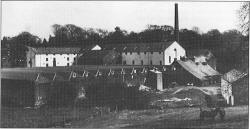 In the
early years of the nineteenth century Hillsborough and Culcavey must
have been ideal places for those fond of a tipple, for the area boasted
a brewery and a distillery. The brewery was a stone structure opposite
the gates of Hillsborough Parish Church and built in a similar style of
architecture. Its water supply was fed from the lake in the Small Park,
while the stream that ran from the lake fed the distillery at Culcavey. In the
early years of the nineteenth century Hillsborough and Culcavey must
have been ideal places for those fond of a tipple, for the area boasted
a brewery and a distillery. The brewery was a stone structure opposite
the gates of Hillsborough Parish Church and built in a similar style of
architecture. Its water supply was fed from the lake in the Small Park,
while the stream that ran from the lake fed the distillery at Culcavey.
The Hillsborough Distillery, as it was called, was built in 1826 by
Hercules Bradshaw on land leased from Lord Downshire. The granting of
this lease put the marquis in a unique and peculiar position. As a
landlord he could inspect his property whenever he took the notion. This
was not the case with the distillery, as the law stated that the Customs
and Excise officials were the only people with right of entry to a
distillery at any time. Lord Downshire's lease allowed for the supply of
water from the Mill Dam over a weir to Culcavey and "the same shall not
be polluted or injured". At this weir an embankment was built to control
and store water � this was known as the Mill Pond. By 1837 the
distillery had three stills and used 2,000 tonnes of grain per year. A
breast wheel and a twenty horsepower steam engine supplied the power.
The hard-pressed breast wheel was described by locals as 'rowdy'! The
supplies of grain and coal reached the distillery from the Lagan Canal
at Newport.
 In addition to the serious commercial
business of distilling we can add a touch of humour by recording the
circumstances under which the Whiskey River acquired its name. It seems
that the distillery had a small customs office between the distillery
building and Mill Pond. The distillery officials discovered that
they had more hogsheads of whiskey in their possession than appeared in
the records. No-one could account how the surplus stock came about, but
through the `grapevine' it became known that the customs men were coming
to inspect the stock. To rectify this state of affairs the workers
pulled the bungs out of the barrels and so the precious liquid flowed
down the river. The villagers came to the riverside with buckets, baths,
crocks or anything that would hold water, and thus they collected the
whiskey. It is said that many locals were drunk for weeks! From that day
onwards the waterway was called the Whiskey River. The
original proprietor of the distillery, Mr Bradshaw, must have been a man
of means, for in 1826 he was able to build himself an ornate house known
as Culcavey Cottage Farm. He demolished an existing property and
constructed a fine house surmounted by a dome situated in landscaped
grounds of one hundred acres. The original entrance was from the
Millvale Road which led along a tree-lined avenue called Green Lane.
From this ran a cobbled road leading to Kennel Hill; so-called due to
the breeding of dogs which took place there. From the vantage point of
his domed house, Mr Bradshaw could watch the Maze races with his
telescope. He seems to have been greatly interested in all things
scientific and was an early exponent of the infant photography industry
� so much so that he owned an early camera obscura. The
brewery in the main street of Hillsborough disappeared some time
probably between 1856 and 1868, and so it is perhaps related that
whiskey distilling at Culcavey ended in 1865. This must, at first, have
seemed like devastating news for the employees and residents of Culcavey
who relied on the distillery for their livelihoods. This must not have
been good news either for those who enjoyed sampling the home grown
produce. However, the commerce of the area was saved when the distillery
premises were taken over by the Hillsborough Woollen Company in 1866.
The company enjoyed a brief `honeymoon' period, before experiencing the
effects of the monopoly of the Yorkshire Woollen Merchants. Given that
county Down was famous for its linen trade, wool could really not
compete, and by 1871 the company began trading as the Hillsborough Linen
Company. As with previous industries on the site, the linen mill relied
on its water supply. Water came from the Mill Pond via sluice gates into
the Mill Race which fed into two large brick tanks sunk into the side of
Culcavey Glen. These were deep and dangerous and occasioned a terrible
tragedy in the 1890s when a young boy lost his life by falling into
them. It was seven days before his body was recovered. This unhappy
episode earned the tanks a nickname � `the coffins'.
Close to the tanks stood the tall brick factory chimney, which spewed
out great clouds of smoke as the fires below created steam to drive the
machinery. Four dams supplied the giant amounts of water needed. The
steam created was used for cleaning, bleaching and heating. It was also
needed to maintain humidity in the weaving sheds where the looms
constantly thundered away creating linen goods that would travel to the
corners of the British Empire. Grey yarn was purchased in hanks and
stored in the old malting lofts until required. It was then bleached,
dried, wound and warped. Finally it was woven into cloth. The types of
cloth woven ranged from damask rose to towelling and more looms had to
be built to meet the demands for these products. Power
from the steam engine was transmitted by a main shaft, cog wheel and
bevel shaft. The looms were all driven by overhead shafts, which were
manufactured by Atherton Brothers of Preston. To maintain production on
this scale, tonnes of coal were required and it was transported via the
Lagan Navigation Canal at Newport Quay. These laborious processes ended
in 1961 when mains electricity was installed. The lapping
room was a substantial three-storey building with a slated roof and it
was here that the cloth was `lapped' until 1908. In this year the
process moved to Belfast due to shortage of labour and the process was
conducted in a warehouse in Bedford Street, which was owned by the
Hillsborough Linen Company. The linen cloth was taken from the factory
by horse and flat four-wheeler van. This horse was called Mr Todd after
a former manager of the factory. The warehouse remained in operation in
Bedford Street until 1960 when traffic congestion and high costs forced
the lapping to be recommenced in Culcavey.
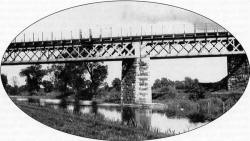 With the
constant roar of activity at the mill and the heavy work and calls of
the bargemen on the canal, Culcavey must have seemed an industrious and
restless place. In 1863 the Lisburn to Banbridge railway line encroached
on the scene, halting at Hillsborough Station. The railway now made the
transportation of goods to and from the factory more convenient, but was
a blow to the canal. The main line from Belfast passed through Knockmore
and the length of the section from here to the level crossing on the
Millvale Road was less than three miles. It was necessary to build road,
river and rail bridges and three level crossings to accommodate the
track. The level crossings were at Ogles Grove, Heatherbank and Millvale
Road. After crossing the river Lagan there was the ten-mile post from
Belfast. With the difference between the flat land at the Lagan and the
highest point at Magherabeg, en route to Dromore, the engineers had
calculated a gradual gradient for this stretch of track. With the
constant roar of activity at the mill and the heavy work and calls of
the bargemen on the canal, Culcavey must have seemed an industrious and
restless place. In 1863 the Lisburn to Banbridge railway line encroached
on the scene, halting at Hillsborough Station. The railway now made the
transportation of goods to and from the factory more convenient, but was
a blow to the canal. The main line from Belfast passed through Knockmore
and the length of the section from here to the level crossing on the
Millvale Road was less than three miles. It was necessary to build road,
river and rail bridges and three level crossings to accommodate the
track. The level crossings were at Ogles Grove, Heatherbank and Millvale
Road. After crossing the river Lagan there was the ten-mile post from
Belfast. With the difference between the flat land at the Lagan and the
highest point at Magherabeg, en route to Dromore, the engineers had
calculated a gradual gradient for this stretch of track.
Hillsborough Station was built on the side of a small hillock on the
Culcavey Road and was a red brick two-storey structure. As well as the
The railway viaduct at Newport ticket office there were waiting and
storage rooms and living quarters for the stationmaster. The social
impact of the railway made journeys to Belfast much easier and more
comfortable than before, although the round trip still took the
traveller a whole day. During the two world wars the railway proved its
worth with a specially constructed halt at Newport to facilitate service
personnel stationed at nearby Long Kesh. The tracks passed over two
notable local bridges called `The Viaduct' and Greer's Bridge'. The
viaduct was a lattice-type bridge which spanned the canal and Dummies
Road. Greer's Bridge was situated at the entrance to Eglantine Cottage
Farm. The locals never used the official names for these structures and
called one `the railway bridge' and the other `the railway arch' or `the
arch'.
Changing social and economic conditions brought
about the closure of this branch line in 1956. The track, bridges and
station were sold and the land offered for sale to the holders of the
original deeds. Remnants of Greer's Bridge and the embankment can still
be seen. The station itself was occupied by a number of tenants,
including Mr Thompson Crossey who operated a scrap business from it.
Sadly, the building has now gone altogether, although a glimpse of the
old railway station at Dromore will give an idea of what Hillsborough
Station looked like as, presumably, they must have been designed by the
same architect.
 By the beginning of the twentieth century
Culcavey was a thriving place where the majority of people had
employment. However, life was hard and made great demands on the
inhabitants, whose lives generally followed a pattern of work, sleep and
worship. The pattern of life was well established and appeared destined
to continue like this forever, but the twentieth century, especially its
latter years, was to witness dramatic social changes in the district.
No-one could have guessed the importance the place would serve in
determining the outcome of the Second World War, or that this importance
would have been underscored by visits from people as distinguished as
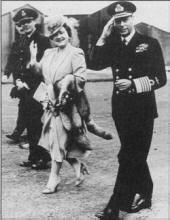 General Eisenhower, King George VI and Field Marshal Montgomery. During
the war the British government was fearful that Hitler's Germany would
use the Republic of Ireland as a back door into Britain as a means of
invasion. The British would, therefore, need to respond quickly using
the air force. And so it was that RAF Long Kesh was set up, along with
bases at Sydenham, Maghaberry and Blaris. Building work at Long Kesh
commenced in November 1940 and culminated in the opening of an airfield
in November 1941. By 1942 the threat of a German invasion of Britain had
receded and a new role was found for RAF Long Kesh. On 1st April 1942
the United States navy commenced a thrice-weekly service between
Eglinton and Hendon (London) airfields, calling at Long Kesh. By the end
of the war the base was used to instruct pilots and crews in the
operation of Beaufort and Hampden aircraft. Throughout the war period
the base saw a succession of aeroplane types which became increasingly
advanced, particularly as US involvement in the war deepened. In the
summer of 1945, and against a backdrop of victory, the base received
visits from senior personages involved in co-ordinating the war. General Eisenhower, King George VI and Field Marshal Montgomery. During
the war the British government was fearful that Hitler's Germany would
use the Republic of Ireland as a back door into Britain as a means of
invasion. The British would, therefore, need to respond quickly using
the air force. And so it was that RAF Long Kesh was set up, along with
bases at Sydenham, Maghaberry and Blaris. Building work at Long Kesh
commenced in November 1940 and culminated in the opening of an airfield
in November 1941. By 1942 the threat of a German invasion of Britain had
receded and a new role was found for RAF Long Kesh. On 1st April 1942
the United States navy commenced a thrice-weekly service between
Eglinton and Hendon (London) airfields, calling at Long Kesh. By the end
of the war the base was used to instruct pilots and crews in the
operation of Beaufort and Hampden aircraft. Throughout the war period
the base saw a succession of aeroplane types which became increasingly
advanced, particularly as US involvement in the war deepened. In the
summer of 1945, and against a backdrop of victory, the base received
visits from senior personages involved in co-ordinating the war.
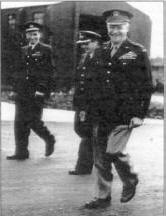 The post-war years saw living standards improve generally and with
consequent developments in technology, and the effects on all aspects of
life, it was inevitable that a little place like Culcavey would
experience change. Consumers became more demanding and expected access
to all the new goods and materials on offer. The world was moving into
an age of synthetic and disposable goods. This applied to the material
which for generations had provided the backbone of life in Culcavey �
linen. The linen industry was severely affected by the production of new
fabrics and fabric mixtures and it was obvious that it could not
compete. In 1966 the din of the weaving shed was stilled and the looms
ceased their labour of more than a century. The Hillsborough Linen
Company closed its premises, cutting in the process the threads of
employment and skill which had long bound the community together. It was
left to the inhabitants of the district to create a new identity and
this they did against a background of enormous physical changes in the
area. With the end of the linen industry the district initially lost
some of the vibrancy which the factory had leant it, and by the 1970s
the number of pupils at Newport Primary School indicated that Culcavey
was experiencing a decline in its population. This was to be
short-lived, as the area soon found itself caught up in the swath of
residential development that has so dramatically changed much of
Northern Ireland. The post-war years saw living standards improve generally and with
consequent developments in technology, and the effects on all aspects of
life, it was inevitable that a little place like Culcavey would
experience change. Consumers became more demanding and expected access
to all the new goods and materials on offer. The world was moving into
an age of synthetic and disposable goods. This applied to the material
which for generations had provided the backbone of life in Culcavey �
linen. The linen industry was severely affected by the production of new
fabrics and fabric mixtures and it was obvious that it could not
compete. In 1966 the din of the weaving shed was stilled and the looms
ceased their labour of more than a century. The Hillsborough Linen
Company closed its premises, cutting in the process the threads of
employment and skill which had long bound the community together. It was
left to the inhabitants of the district to create a new identity and
this they did against a background of enormous physical changes in the
area. With the end of the linen industry the district initially lost
some of the vibrancy which the factory had leant it, and by the 1970s
the number of pupils at Newport Primary School indicated that Culcavey
was experiencing a decline in its population. This was to be
short-lived, as the area soon found itself caught up in the swath of
residential development that has so dramatically changed much of
Northern Ireland. In the period since the 1970s the
district, once known for its linen manufacture, became known for very
different reasons. With the onset of the `Troubles' in 1970, the Long
Kesh base was brought back into service as a prison to detain those held
under Brian Faulkner's policy of internment. This ensured that the Maze
was never far from the public gaze. The eyes of the world were turned on
the area in 1980and 1981 during the tense period of the hunger strikes
by republican prisoners in the `H-blocks'. The Maze Prison again came to
prominence during and after the Good Friday Agreement of 1998, which
instigated the prisoner release programme. Due to this the prison closed
in 2000, once again creating the potential for change.
People often fear change and this is understandable when the change is
rapid. The visitor of today would hardly recognise the Culcavey,
Halftown or Maze of thirty years ago. The mill, for so long the focal
point of the area, has gone. Indeed, even its buildings have gone, being
demolished to make way for houses in 1993. The proximity of the district
to Hillsborough accounts for its popularity for housing, but few would
probably appreciate the very independent development the area has had
over many generations and that the names of new developments, such as
`Old Mill Heights', recall that heritage. This book does that through
the eyes of those who have lived through these changes.
 A
CHANGING SCENE
The two mile journey from Hillsborough to Halftown would be just 'a nice
stretch of the legs', but makes an interesting excursion to the
perceiving eye if we can go back in time and remember how it used to be.
HILLSBOROUGH NURSERY
Situated on the left-hand side at the bottom of the hill on the Culcavey
Road out of Hillsborough just before the railway station, the Nursery
ran from the Culcavey Road to the Millvale Road. Mr & Mrs Bob Bell, the
owners, lived in a house on the Millvale Road and the Nursery was really
their large, expansive back garden. Row upon row of greenhouses nestled
in the hollow. The soil was fertile and lush and the Bell's knew their
job and their market. Mr Tom McQuade was their foreman and lorry driver,
overseeing the workers and taking the produce to shops and markets.
Young and old were employed here, and if you were a good worker you were
welcome. Here was the nursery business at its best, all the age-old
methods employed in producing first-class plants. These nurserymen knew
their skills and there were no short cuts in those days.
When Mr & Mrs Bell retired Tom McQuade took over the Nursery for a good
number of years until he too retired. Now all we have in its place are
red brick houses that extend right to the Millvale Road.
THE RAILWAY
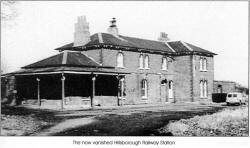 The railway arrived in this area on 13 July 1863 with the opening of the
Banbridge, Lisburn and Belfast Railway. The line was later taken over by
the Ulster Railway and eventually became part of the Great Northern
Railway. The construction of the railway had been an enormous
undertaking and it had cut its way through the countryside of county
Down. And it has left its mark - most notably in the magnificent viaduct
at Dromore. The railway arrived in this area on 13 July 1863 with the opening of the
Banbridge, Lisburn and Belfast Railway. The line was later taken over by
the Ulster Railway and eventually became part of the Great Northern
Railway. The construction of the railway had been an enormous
undertaking and it had cut its way through the countryside of county
Down. And it has left its mark - most notably in the magnificent viaduct
at Dromore. Hillsborough Station was situated on the
Culcavey Road and was a building typical of the time - two-storey, red
brick with arched windows and ornate over-hanging eaves. All was
contained under one roof, from the ticket office to the Stationmaster's
house. A siding and goods shed catered for all kinds of merchandise and
there were pens to assist with the movement of livestock. Not only did
the trains make travel more convenient, but the strict adherence to
time-keeping meant that the locals could tell the time of day by the
punctual appearance of a train. The canal was crossed by an iron
lattice-work viaduct supported on stone piers.
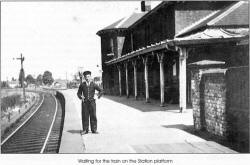 During the
Second World War the threat of air raids meant that valuable goods were
dispersed throughout the countryside and many goods trains carried loads
to Hillsborough Station under the cover of darkness. To keep this
section of line in good order a team of men carried out regular safety
and maintenance work. A workman carrying a wrench-cum-hammer over his
shoulder carried out the inspection, checking and tightening each nut on
the line. During the
Second World War the threat of air raids meant that valuable goods were
dispersed throughout the countryside and many goods trains carried loads
to Hillsborough Station under the cover of darkness. To keep this
section of line in good order a team of men carried out regular safety
and maintenance work. A workman carrying a wrench-cum-hammer over his
shoulder carried out the inspection, checking and tightening each nut on
the line. Just as the railway had robbed the canal of
much of its business, so the advent of the motorcar deprived the railway
of its custom, and the branch line closed in 1956. The monuments to the
Victorian engineers - the bridges, the embankments and the great steam
engines- all disappeared from the scene. Even the railway station has
now vanished, having survived for a while as the premises of a scrap
business. However, the railway is not forgotten, for it is still common
to hear older residents refer to the Railway Road, before correcting
themselves and saying Culcavey Road.
CULCAVEY COTTAGE FARM (LATER CULCAVEY HOUSE)
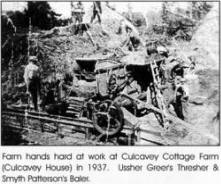 As you pass under the bridge spanning the A1 dual carriageway, and what
was once the railway bridge, the first hill you see in the distance is
locally called McBride's Hill. Before you traverse this hill the lane
way on the left-hand side was the original entrance to Culcavey Cottage
Farm (later Culcavey House), built in 1826 by Mr Hercules Bradshaw, the
original proprietor of Culcavey Distillery. (It should be noted that a
'Culcavey House' existed long before Mr Bradshaw's dwelling was
constructed, but on an entirely different site - as will be seen from
later information in this book.) For those who can remember this ornate
residence of Mr Bradshaw, the one thing that stands out in recollection
is the large dome that graced the top of the house and gave an
outstanding view of the surrounding countryside. But for many this was
the only thing they saw of the house set in its own extensive grounds. As you pass under the bridge spanning the A1 dual carriageway, and what
was once the railway bridge, the first hill you see in the distance is
locally called McBride's Hill. Before you traverse this hill the lane
way on the left-hand side was the original entrance to Culcavey Cottage
Farm (later Culcavey House), built in 1826 by Mr Hercules Bradshaw, the
original proprietor of Culcavey Distillery. (It should be noted that a
'Culcavey House' existed long before Mr Bradshaw's dwelling was
constructed, but on an entirely different site - as will be seen from
later information in this book.) For those who can remember this ornate
residence of Mr Bradshaw, the one thing that stands out in recollection
is the large dome that graced the top of the house and gave an
outstanding view of the surrounding countryside. But for many this was
the only thing they saw of the house set in its own extensive grounds.
The house for a good number of years was the home of the McBride family,
who still reside in the area, and in latter years was known locally as
McBride's House. Colin Fowler's father Bertie, whose mother was a
McBride, was born in this house, and in later years when its grandeur
was in decline Colin himself resided there for a few years. His
description of the inside gives an insight into the size and
magnificence of this gentleman's residence. The avenue
to the house was lined at that time with many beautiful trees, yew,
golden cypress and juniper, with one magnificent cedar reputed to be the
largest in Britain. The house itself was a
splendid building with many rooms and servants' quarters, these being
connected to the rest of the house by a system of signal bells operated
by hand pulls and linked together by wires. The ground floor had many
fine rooms fitted with Italian marble fireplaces and with french-windows
opening directly onto well-kept lawns. These rooms included a grand
ballroom with parquet flooring and a very large dining room paved with
sandstone flags. A most unusual feature of the
upper storeys was a winding staircase leading to a glass dome towering
above all the rooftops. It was said that from this vantage point the
Maze races could be watched through spyglasses.
The McBride family in those days would have probably been considered as
landed gentry. Their mode of transport was by carriage and they had many
stables and horses with their own blacksmith's shop. They also had boats
on the lake below the house, and this lake they had stocked with rainbow
trout as most of the family were keen fishermen. The large estate
included separate housing for several .families' employed on the land,
and there so far as we can tell they all worked happily and harmoniously
together. This of course was in the good old days when farming was still
a gainful occupation. It was rumoured that the
house contained a secret escape tunnel or bolt-hole, but this was so
well hidden that it could never be found. Many old
houses have supernatural stories attached to them, and Culcavey House
was no exception with tales of dreadful apparitions floating several
feet above the ground being seen on certain nights. Then too the
headless horseman who still managed to utter a horrid laugh, and other
things unseen with much clanking of chains and rattling of bones!
Now that the old mansion has alas long gone these phantoms have most
likely all retired on good pensions!

THE INKPOT
Opposite the entrance to Culcavey Cottage Farm (later Culcavey House)
stood the Inkpot. This was a small house and so-called because of its
appearance with a chimney at the summit of a four-sided roof. The
cottage was a square, measuring 25 feet by 25 feet. The occupant was
responsible for opening and closing the entrance gates to Cottage Farm.
HEATHERBANK FARM
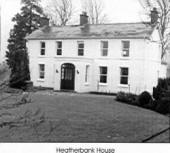 Situated on the right-hand side at the brow of what is locally called
McBride's Hill was Heatherbank Farm. This two-storey house was
surrounded by fields and adjacent to the railway. Here was a railway
crossing known as `Heatherbank Crossing'. Edwin George Sands and his
wife Sarah occupied the house at one time. Edwin Sands was born in 1853
and died in 1925, whilst his wife was born in 1859 and died in 1935.
(The Sands family is mentioned later in this book in connection with
farming.) They sold the property to a Mr & Mrs William Flynn. In later
years it was the home of Situated on the right-hand side at the brow of what is locally called
McBride's Hill was Heatherbank Farm. This two-storey house was
surrounded by fields and adjacent to the railway. Here was a railway
crossing known as `Heatherbank Crossing'. Edwin George Sands and his
wife Sarah occupied the house at one time. Edwin Sands was born in 1853
and died in 1925, whilst his wife was born in 1859 and died in 1935.
(The Sands family is mentioned later in this book in connection with
farming.) They sold the property to a Mr & Mrs William Flynn. In later
years it was the home of
Mr & Mrs Hamilton Bell. Mr Bell operated a Saw Mill here for cutting
trees into planks. The house still remains but the farmland around it
has been developed into private housing.
MILL POND
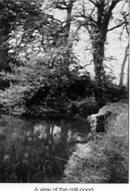 To the people of Culcavey Village `Mill Pond' was commonly referred to
as `the dam' or 'McBride's dam'. The water from Mill Pond, via the
sluice gates, entered the Mill Race situated on elevated ground on the
west side of Culcavey Glen. The Mill Race flowed onwards into two large
brick built tanks sunk into the side of the Glen. Here was the source of
power to generate the Linen Mill. The overflow from the Pond traversed
down the Whiskey River. To the people of Culcavey Village `Mill Pond' was commonly referred to
as `the dam' or 'McBride's dam'. The water from Mill Pond, via the
sluice gates, entered the Mill Race situated on elevated ground on the
west side of Culcavey Glen. The Mill Race flowed onwards into two large
brick built tanks sunk into the side of the Glen. Here was the source of
power to generate the Linen Mill. The overflow from the Pond traversed
down the Whiskey River.
In early years the Mill Pond
contained many species of fish found in fresh water ponds. The arrival
of eels via Lough Neagh and the Canal put paid to the fish. For those
who can remember the eels were extremely large, silvery and
slippery. Perhaps to generations of children the dam was
a place where you could wander round in search of birds' nests, try to
catch fish or eels, or even at the shallow edges sit on a grass bank and
paddle your feet. Today it is a haven for the many ducks and swans who
feed uninhibited. BRADSHAW'S NURSERY
On the opposite side of the road to the entrance of Mill Pond was
Bradshaw's Nursery. The Nursery extended as far as Culcavey crossroads
and in its time must have been one of the largest in the Province. Local
information states "that over 100 men were normally employed here, and
extra `hands' were taken on in the height of the season". The area was
originally known as `Ogles Grove', but employees called it Bradshaw's
Nursery because the Marquis of Downshire's gardener, Mr Bradshaw
supervised it. Mr Lennox Davis succeeded Mr Bradshaw. Thorn quicks,
decorative hedges, shrubs and trees were propagated, cultivated and
despatched from the Nursery. The Nursery was still in operation in 1931
when Mr Arthur Walker (father of Stewarty Walker), who was head
gardener, died whilst conducting business at Belfast Market.
The following part of a poem, whose author is unknown, is a reminder of
the above era: Ogles Grove �
The Seat of Henry Davis, 1834 As o'er the plain
my ramblings I pursue
An Ancient spot burst forth upon my view.
Neat handsome plantings on each side arise,
Here blooms the pride of modern nurseries.
What wonderful taste! It seems the bower of love.
Oh! Let me breathe the air of Ogles Grove.
Who has not felt in such a scene as this
The thrilling joy of summer's evening kiss?
His spirit dancing, while the hum of bees
Rose on the pinions of the sconce-felt breeze.
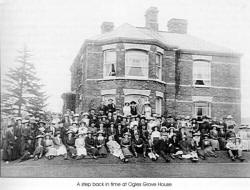
OGLES GROVE HOUSE
This tall imposing red brick residence was situated up a long lane-way
on the right-hand side of the road just past Mill Pond. It was the
original residence of the Pimm family. The Pimm family sold the house to
Mr Marshall, a Miller of Victoria Street Belfast. Mr & Mrs Parks were
the next owners, Mrs Parks being a member of the Cowdy family from
Banbridge who owned the Linen Mill, and Mr Parks a retired Army Colonel.
Finally the last owners of this lovely house were Mr & Mrs Boyd. Mr.
Boyd was a bank official for the Ulster Bank. Sadly the house was
demolished a few years ago and the grounds are filled with new modern
dwellings.
 MILL HOUSE AND MILL
COTTAGE (or Glen Cottage)
Almost opposite the entrance to Ogles Grove House stood Mill House, a
two-storey dwelling owned by the Mill and a `tied house', one had to
work in the factory to occupy it. As the nearest house to Mill Pond
(dam) the tenant was responsible for opening the sluice gates each
morning to generate the power for the Linen Mill, and perform the
opposite function at night when power went off at 10.00 p.m.
Mill Cottage (or Glen Cottage) stood slightly further down at the top of
what was known as the Factory Hill. This would originally have been the
Customs House. Although a two-storey structure, from the front one would
expect it to be one-storey, as it was in fact built into a hill. Three
bedrooms merged off the hallway at the front door. You went down a few
steps and a small box room was on your right, the door on the left led
down another few steps into a large kitchen (living room). Running off
this large room was a scullery (kitchen) and another room used as a
store room. There was a fire in one of the bedrooms and a large range in
the kitchen. Water was carried from the tap just inside the Mill gates
at the bottom of the hill. Electric light was generated from the Mill,
with the exception of the bedroom on the right-hand side, which for some
reason had no access to lighting. Joining onto Mill Cottage was another
building known as `the Reading Room'. Its purpose must have something to
do with work in the Mill. A dry toilet was outside, situated on a steep
bank almost overlooking the waterfall in the glen. A pathway led
directly from the house down to the Whiskey River. The gardens were
extensive, the front garden ablaze with flowers and a rose arch at the
front door. The back garden held a good chicken run and lots of space
for cultivating.
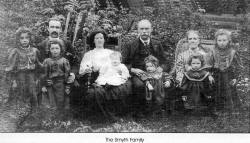 The photograph opposite, taken between
1910-1912 shows the Smyth Family at Glen Cottage. Sitting from left to
right, William John Smyth and his wife Sophia, Henry Smyth and his wife
(parents of William John). Standing left to right the children are,
Dorothy, Madge, Sophia, Hennie and Minnie with Winnie sitting on
mother's knee. Henry Smyth was Assistant Manager of Culcavey Linen Mill
and William John was Winding Master. The rest of the family all worked
in the Mill at various jobs. The photograph opposite, taken between
1910-1912 shows the Smyth Family at Glen Cottage. Sitting from left to
right, William John Smyth and his wife Sophia, Henry Smyth and his wife
(parents of William John). Standing left to right the children are,
Dorothy, Madge, Sophia, Hennie and Minnie with Winnie sitting on
mother's knee. Henry Smyth was Assistant Manager of Culcavey Linen Mill
and William John was Winding Master. The rest of the family all worked
in the Mill at various jobs. The family suffered
tragically while living here. Henry Harry Smyth, son of William and
Sophia, born on 20th April 1911 was drowned at the back of the house in
the Whiskey River on 15th March 1914. The postman accidentally left the
side gate open and the lure of the water proved tragic, his body was
found further down the river at the Linen Mill. The family moved from
the Glen and took up residence at No. 15 Grey Row which at that time was
quite an expansive house, occupying the whole corner site. Part of No.
15 was later annexed to provide a smaller dwelling for the Factory
Manager's housekeeper. The bigger house provided ample space for this
large family: Minnie (born 12th July 1899), Dorothy (born 5th February
1902), Madge (born 20th March 1904), Hennie (born 16th November 1905),
Sophia (born 17th April 1907), Winnie (born 10th August 1909), Florrie
(born 20th December 1913), Ethel (born 4th March 1918) and Harold (born
2nd March 1920). Colin Lillie from Hillsborough, whose
mother was Dorothy Smyth, recalls vividly his mother's recollections of
life at Glen Cottage, and how she left the house at Grey Row to get
married. His grandmother, Sophia, never really got over the death of her
young son and died at the early age of 43. THE GLEN
Culcavey Glen nestled between Culcavey Road, the Mill Pond, Mill Race
and the Factory, and for the people of the village it was a magical
place. The Whiskey River meandered from the Mill Pond (dam) down through
the Glen and via the Mill continued on down the back of the houses in
the village. To remember the Glen is to think of quietness in its leafy
depths, the birds singing, sound of the waterfall cascading down the
rocks. Carpets of bluebells grew in the dappled shade, primroses peeped
from the edges of the river. There was an assortment of broad-leafed
trees, tall ferns, brambles and bushes. For children it was an enchanted
world to explore, things to be done and found in all seasons � looking
for birds nests, home-made swings on the trees, climbing the almost
mountain-like banks up onto the Culcavey Road, looking for chestnuts in
the autumn and blackberries in the summer. To remember, just close your
eyes and think back to the tall trees rustling above you, the peace and
quiet and no background noise of traffic or modern day life. It was a
timeless
place, taken for granted and only really appreciated
when it had disappeared.
THE MILL � HILLSBOROUGH LINEN COMPANY
Although we have already said something of the history and importance of
the mill, it is interesting to read what Bassett's County Down Guide and
Directory had to say about the factory in 1886.

The Hillsborough Linen Company, Limited
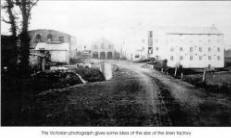 The factory of the Hillsborough Linen Company, Limited, is situated
at a distance of about a mile, English, west of Hillsborough, and less
than hall a mile from the railway station. Buildings, three storeys and
two storeys high, cover about two acres, and on 26 acres there are 52
workmen's houses. Altogether, the premises consist of about 140 statute
acres, including a grazing farm. There are 318 looms, with the latest
improvements. The manufactures include towellings, diapers and damasks.
Yarns spun from Irish and Belgian flax are chiefly used. The products
are sent to the markets of the United Kingdom and to the United States
and Canada. An engine 135 horse-power, drives the machinery in summer.
In winter a turbine wheel, equal to 70 horsed-power, is used as an
auxiliary. The factory of the Hillsborough Linen Company, Limited, is situated
at a distance of about a mile, English, west of Hillsborough, and less
than hall a mile from the railway station. Buildings, three storeys and
two storeys high, cover about two acres, and on 26 acres there are 52
workmen's houses. Altogether, the premises consist of about 140 statute
acres, including a grazing farm. There are 318 looms, with the latest
improvements. The manufactures include towellings, diapers and damasks.
Yarns spun from Irish and Belgian flax are chiefly used. The products
are sent to the markets of the United Kingdom and to the United States
and Canada. An engine 135 horse-power, drives the machinery in summer.
In winter a turbine wheel, equal to 70 horsed-power, is used as an
auxiliary. The buildings belonging to the
Hillsborough Linen Company Limited originally served the purposes of a
distillery, operated until the time of his death, about twenty years
ago, by Mr. Hercules Bradshaw; a celebrated man of the turf and the
owner of Barbarian, once a favourite for the Derby. A short time after
the demise of Mr. Bradshaw the distillery was acquired by a Limited
Liability Company and changed into a woollen factory.
A second limited liability company was formed while the concern was
in full operation. It bought out the first company and continued to work
until 1876, when a change was made .from woollens to linens, the company
re-organised and its name altered to the Hillsborough Linen Company,
Limited. Some of the shareholders of the first company have stock in the
present successful enterprise. Mr J.J. Pimm of
Lisburn, is managing director, and Mr. Arthur Pimm secretary. Mr Arthur
Pimm resides at Culcavy Cottage, in handsomely planted grounds. About
300 people are employed in the factory, of this number more than half
are females. At the entrance to the factory there
is a school under the National Board of Education. It is chiefly
attended by children of the company's operatives. The first storey of
the school-house serves as a reading and recreation room. It was
established by the company for the workmen, who manage it by committee.
for their own benefit. MILL PEOPLE
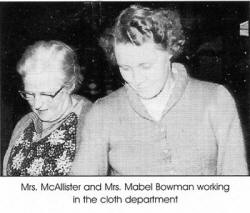 For generations the mill provided the means of existence for a large
proportion of the local population and this was often readily
acknowledged. The Ulster Star of 9th November 1957 produced an article
on the work of the Hillsborough Linen company. This article has been
used to piece together information about the mill workers. For generations the mill provided the means of existence for a large
proportion of the local population and this was often readily
acknowledged. The Ulster Star of 9th November 1957 produced an article
on the work of the Hillsborough Linen company. This article has been
used to piece together information about the mill workers.
The Star noted that, in 1957, Andrew Armstrong had just replaced James
McCandless as factory manager, while Robert Wilkinson was the assistant
manager. Many of the employees had worked in the mill all their adult
lives, one such person being Agnes Kane, who worked in the warp winding
section for over sixty years. Matt Spence, a tenter, worked in the
factory for over forty years. Warren McCleary was the father of Ernie
McCleary, the Cliftonville footballer and Irish Amateur International.
The article went into a great deal of detail and mentioned the names of
people long-associated with the factory: Boreland; Bowman; Bryans;
Cairns; Copeland; Hewitt; Harris; Hull; Kane; Ringland; Pollock; Spratt;
Walker; McAllister. It is interesting to note that the
Star went to great pains not to divulge any of the mill's trade secrets
� they obviously didn't want to help the competition!
Herbert Bell of Tullynore, Hillsborough, had his own recollections of
many of these people and their work: I went to work in
Culcavey Factory in 1931/32. I was learning weaving. for a short period,
then working at bleaching yarn, and later I was operating a cropping
machine in the cloth office. The older person on the large machine was
George Cunningham; he was reared at Chimney Hall, Lisburn Road. The
cloth inspector was Waring McCleery .from Moira, and he was married to a
Uprichard. There were four Bowmans: Dad (boilerman); Stanley (dressing
machine); Walter (labourer) and May (winder). I
also worked with Stewart Walker when we whitewashed all the buildings.
Gerald Sparrow was in charge of bleaching, Harry Smyth was a joiner and
Harry's brother was winding master. Albert Pollock and Davy Johnston
were at bleaching. Davy's father was watchman at night. Manager
McCandless lived at the back. Mr Wilkinson was floor manager William
McAdam transported materials from Belfast by horse and van. The other
dresser was Jimmy McMaster There were two men working on damask looms,
Scott and Flanagan � I think they went overseas to work.
Annie McClenaghan (nee Ball) provides a lifetime recollection of work in
a linen mill: I started work in Culcavey Factory as a
Weaver at the age of 14. This was the main work place for most of the
girls and women of the village and my mother introduced me into the
intricacies of the trade. It was hard work and the youth of today would
probably be horrified by the conditions under which we toiled, the
noise, dirt and the cold. We put in a six day
week, Monday to Friday 8.00 a.m. to 6.00 p.m. and Saturday 8.00 a.m. to
12.30 p.m. More than welcome was the cup of tea we got at our loom at
10.00 a.m. When 12.30 p.m. arrived it was lunch break, but we had to be
back at work at 1.00 pan. For some it meant a `piece' (sandwiches)
consumed on the premises, but a .few managed to run home for a quick
bite.
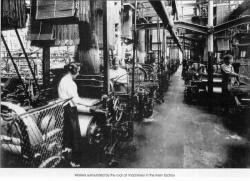 The weavers' tools were a haddle hook (held
in your mouth all day) and scissors (held in your hand all day). The
women staved off the dirt by wearing an overall to save their clothes.
If your loom stopped functioning the men would be called on to do the
repairing or .fixing, but as time meant money to the weaver the women
sometimes became just as adept at the fixing and carried their own
tools. I remember one method I was involved in was the supply of small
cuttings of dry rabbit skin glued and put in the shuttle to stop the
weft breaking. As my father Hugh was the main supplier of rabbit skins
in the area I was often sent post-haste home to procure the necessary
bits of skin. Another necessary task was cleaning the looms every
Friday. We were the producers of the best damask table cloths, tea
towels and deck chair covers, the latter of which would cut the hands
off you. The weavers' tools were a haddle hook (held
in your mouth all day) and scissors (held in your hand all day). The
women staved off the dirt by wearing an overall to save their clothes.
If your loom stopped functioning the men would be called on to do the
repairing or .fixing, but as time meant money to the weaver the women
sometimes became just as adept at the fixing and carried their own
tools. I remember one method I was involved in was the supply of small
cuttings of dry rabbit skin glued and put in the shuttle to stop the
weft breaking. As my father Hugh was the main supplier of rabbit skins
in the area I was often sent post-haste home to procure the necessary
bits of skin. Another necessary task was cleaning the looms every
Friday. We were the producers of the best damask table cloths, tea
towels and deck chair covers, the latter of which would cut the hands
off you. The terminology of the workers is
ingrained in everyone who worked in the linen trade. The warp winding,
weft winding, slashers, lapping, drawing in, bobbin hole, tenter,
fitter, reel bleaching, yarn drying, cloth passer, joiners,, fitters
etc.
Jimmy McNally and Stanley Bowmen were slashers, Matt Spence was the
tenter, George Gunn, Bertie Cairns and Jim McCauley .fixed wood on the
looms. Norman Chapman and Cecil Harrison were fitters (fixing metal on
the looms). Jimmy Walker put stoppers on hand shuttles, not a very nice
job as you had to suck them. George Humphries swept the floor all day
long to try and keep the dust and dirt down.
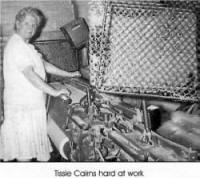 The
company and the fun we had are what memories are made of If a girl was
getting married she was put into the weavers' truck covered in french
chalk and pushed around the mill. The
company and the fun we had are what memories are made of If a girl was
getting married she was put into the weavers' truck covered in french
chalk and pushed around the mill. I worked in the
mill for 18 years until it was closed in 1967. My redundancy was �101
and I really thought I was rich! But the hard work didn't put me off,
because I continued my trade in the Ulster Weaving Company in Sandy Row
for another 24 years. For people who worked in the
mill many would ask the question "How do you know a mill worker?" and
the answer would be "They all speak loudly"! To those
who spent the days toiling in the linen trade they not only remember the
working conditions but also the people they worked with. One such person
was Mr William Johnstone from Hillsborough, the night watchman
responsible for closing all the gates and making his rounds of the
factory. His hurricane lamp lit up many a dark night. It was also his
duty to stop and start the dynamo-driven engine which produced
electricity for the village and to keep the boilers lit until the
boilerman came to work at 6.00 a.m. in the morning. The harsh and
hazardous conditions that the mill people worked in would not be
tolerated today. From the cleaning of the coal fired boilers where a man
had to enter the boiler and chip (de-coke) all the limestone which had
accumulated and remove it outside for disposal. Pitch dark inside and
without ventilation or light there were no safety regulations here. The
cold, noise and humidity were horrendous. Gas could be seen rising from
the pots that the yarn was steeped in. Chemicals including vitrol and
clard lime were used. Masks were unheard of then. The dust, known as
pouse, covered everything, including the workers. James
McCandless, known to his workers as `Pa McCandless', was a respected and
feared man. He not only held sway over his workers in the mill but also
in their family lives. This was the man who could give you the `sack'
and deprive your family of a home. But he ruled the factory and the
village houses with vigilance, and appeared to know everything that was
going on. He had a wealth of experience to call upon in his capacity as
Manager as he had successfully managed a factory in Russia in his youth.
His honeymoon was spent sailing on the River Volga. Armed men approached
him after the Russian Resolution and asked him to manage the factory for
them. The Manager's house was situated towards the back
of the mill on the left-hand side. A one-storey structure well enclosed
in its own grounds. A well-tended garden extended to the left of the
house, kept weed-free and full of vegetables, fruit and flowers, by the
gardener/handyman employed by the Mill. Pa McCandless and his wife had
one daughter called Annella. Miss Alice Taggart, who lived in No. 16
Hillside Terrace with her sister, was employed as their Housekeeper.
Miss Taggart spent her retirement in Hillside Terrace and lived to a
ripe old age. For the people who worked in the Factory
their experience of the hard work, the laughter and the tears, the
sharing and the caring could produce a book in itself. These were the
days when you walked to work, or if you were indeed lucky made your way
by bicycle, from not only Culcavey but also Hillsborough, Maze and
surrounding areas. Time was strictly monitored and you had to be
punctual no matter how far you had to travel. At the beginning of the
day you entered to the thunderous sound of the mill at work, and many of
the workers became adept at lip-reading, so great was the noise. What
many of the weavers and winders earned was governed by what they
produced. A bad batch of yarn would mean a meagre pay packet. Here was
one big family, each reliant on the other in the effort to produce high
quality linen.

OGLES GROVE FARM
Ogles Grove Farm was built on part of the land that would have been
Bradshaw's Nursery. Bertie and Norma Higginson lived here until they
emigrated to Australia in the 1950's. In the late I920s the area which
is now called Eglantine Park was still covered with shrubs and trees
which were removed with the aid of a steam engine. As Norma Higginson
recalls life on the farm was vastly different to what it is today.
After the Second World War agriculture in Northern Ireland was being
boosted along with new ideas, more up-to-date machinery, and new
ventures were the order of the times. My late husband, Bertie, had taken
delivery of a new Nuffield tractor (the first in the area), his
ambitions were to increase our acreage and make Ogles Grove Farm larger
and more productive. The 'factory land' as it was known, became
available for renting, this was just across the road and too good to
miss. We increased our acreage of potatoes the first year (1948/49). The
land had not been tilled for some years so it grew excellent crops in
those early years. Our herd of dairy cows was
producing milk. for the factory residents who lived alongside at
Culcavey in those red brick and grey pebbledashed rows of houses, just
beyond Mr Emerson's shop. Granny Higginson would deliver, on her
bicycle, the gills, pints and quarts of fresh milk required every
morning. Milking commenced well before breakfast. The big white cow
always had first attention; her milk would be oozing onto the byre floor
before we even started. The `kicker' was always left to the last, she
had to be leg roped, otherwise her foot would end up in a full bucket of
fresh milk! The family cats sat nearby, and it was fun trying to squirt
milk to their lips, often missing and ending up around their whiskers!
Ogles Grove Farm produced early vegetables .for the Lisburn market
and local shops. Bertie grew early cauliflowers. I remember well that
each plant had to have one teaspoonful of Sulphate of Ammonia sprinkled
around its base, just as the head was starting to develop.
The three hothouses grew early lettuce, followed by a crop of
tomatoes. Nothing beat a fresh young tender lettuce, with home made
dressing, garnished with young tomatoes. The
railway line divided two fields from the main part of the farm. One
frosty morning we could hear the train whistle blow frantically.
To our amazement a sow with ten suckling pigs had ventured onto the
line. Fortunately they scattered in all directions, so the 10.00 am
train had a clear passage to the Hillsborough Station just half a mile
away. This was counted as a close shave as the sow and her family should
not have been there! The early fifties brought new
horizons to our lives. There was a big movement of people to Canada and
lots of families were losing their sons and daughters to this great
continent. Australia seemed very far away. We had connections there, and
letters had been coming and going since the early thirties. In those
early years the letters referred to droughts and more droughts, with sad
tales of shooting sheep and horses as the crops had .failed. However,
after the war, pasture improvements took over in the heavier rainfall
areas around the Riverina in New South Wales. Times had greatly improved
� the wool boom had given the farmers a great boost, people were
prospering and life was much easier. During
1952/53 Bertie travelled to see for himself what the life and
opportunities were like in Australia. He spent twelve months studying
farming in Australia and New Zealand. He was fortunate to see four
seasons in Australia and judge for himself. He returned in October 1953
with news that opportunities were many `down under' � land was plentiful
and reasonable compared to Northern Ireland and England.
A big step was taken and early in 1954 Ogles Grove Farm was sold to
the Walker family, who farmed the land until it was sold for private
building. On 17th March 1954 we set sail on the SS Orsova, making her
maiden voyage, to Australia. There was Bertie, myself and our two
children, Carole and John. Much water has passed
under the bridge since those early days of married life in Culcavey. It
has been experience that my family has never regretted making.
 THE VILLAGE & ITS PEOPLE
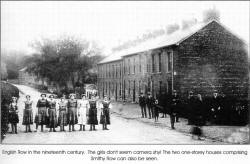 From Smithy Row, English Row, Shop Row, Hillside Terrace, Thompson's
Row, Puddledock Row, the houses were the property of the Mill. The
houses were `tied', one member of the family had to be employed by the
Linen Company in order to attain and maintain tenancy. The fear of
losing a job was bad enough, but it also meant losing a house. From Smithy Row, English Row, Shop Row, Hillside Terrace, Thompson's
Row, Puddledock Row, the houses were the property of the Mill. The
houses were `tied', one member of the family had to be employed by the
Linen Company in order to attain and maintain tenancy. The fear of
losing a job was bad enough, but it also meant losing a house.
The maintenance of the houses in the village was the responsibility of
Mill owners, but they were far from luxurious accommodation. The usual
accommodation was a living room (known as the kitchen) with a kitchen
(known as the scullery) off and two-three bedrooms, depending on which
row you lived in. There was no bathroom, toilet or running water.
Electricity was supplied by the factory generator, but was only strong
enough for lighting purposes. Power started at around 7.00 a.m. in the
morning and went off at 10.00 p.m. at night. As there were no street
lights, there was a world of darkness outside at night, with the bats
sweeping up and down the rows of houses come dusk. For
most people the toilet was at the bottom end of the back garden, and a
dry toilet at that. The more fortunate of the tenants who had a
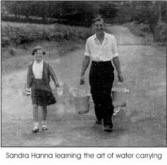 back
yard had `the wee house' situated just outside their back door. Few had
a china chamber pot, 'po', under the bed and had to make do with a
bucket. The ritual of `emptying the bucket' out of the dry toilet was
usually done under cover of darkness. Usually a hole was dug in the
garden and it was disposed of there � so much for the claims about the
huge vegetables grown years ago! But there was at one time a dump
created for the disposal of the `bucket'. This was situated less than
100 yards from the only village pump and well which was the main supply
of water for drinking and washing purposes. In the darkness the `bucket'
was emptied and then rinsed under the pump, which meant the water must
have returned to the well along with everything else! When the dump was
full and there was no more room to empty the `bucket', William Crossey,
Sen., was paid to make room. He got a horse and cart and a long-tail
shovel and drew all he could out of the dump and spread it beside the
Whiskey River. There were no septic tanks or sewage plants and the well
never ran dry no matter what the weather. The `good old days'! back
yard had `the wee house' situated just outside their back door. Few had
a china chamber pot, 'po', under the bed and had to make do with a
bucket. The ritual of `emptying the bucket' out of the dry toilet was
usually done under cover of darkness. Usually a hole was dug in the
garden and it was disposed of there � so much for the claims about the
huge vegetables grown years ago! But there was at one time a dump
created for the disposal of the `bucket'. This was situated less than
100 yards from the only village pump and well which was the main supply
of water for drinking and washing purposes. In the darkness the `bucket'
was emptied and then rinsed under the pump, which meant the water must
have returned to the well along with everything else! When the dump was
full and there was no more room to empty the `bucket', William Crossey,
Sen., was paid to make room. He got a horse and cart and a long-tail
shovel and drew all he could out of the dump and spread it beside the
Whiskey River. There were no septic tanks or sewage plants and the well
never ran dry no matter what the weather. The `good old days'!
For all the women of the village wash day and bath night was a
nightmare. All the water had to be carried from the pump, bucket by
bucket. Pots and buckets of water were heated on the range in the
kitchen and transferred to the washtub in the scullery. Vigorous
scrubbing on a `scrubbing board' using hard green bars of soap. More
water for rinsing and then out into the back yard to be put through a
mangle to squeeze whatever water you could out of the laundry before
being pegged out on the line. The pump wasn't just situated near your
house, for many it took a few hundred yards to collect the water and
bring it back to the house. Back-breaking and continuous on laundry day,
with the prospect of facing the water carrying again on Saturday night
for the weekly bathing session. Here the tin bath was taken out of the
yard and set in front of the range in the kitchen. The family took turns
in the bath, the youngest first down to the eldest of the children,
usually sharing the same water with a top-up from the kettle. Adults
performed the same process usually later in the night when the children
were in bed. As there was a fireplace in a bedroom upstairs, the fire
was sometimes lit and the bath and hot water lugged up the stairs in
order to give more privacy to older members of the family.
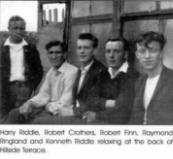 The only heating in the houses was from the range in the kitchen, and
life usually revolved around this. Here was the heat, here was the means
of cooking, and in winter the clothes were dried as well, sometimes on a
pulley line or on a clothes-horse in front of the range. Pride of the
kitchen was the range, black-leaded and polished and looked after as the
most important part of the house. Porridge cooked for breakfast, soup
simmering for dinner (if you were lucky), and bread and jam for your
lunch (your `piece'). Nothing fancy, nothing wasted, and the better-off
people managed to cook tarts and cakes in the oven, but for most this
wasn't possible. Fuel to maintain the continuous heating required for
the range sometimes posed a problem. Most people would burn logs or any
bits of wood that came to hand to eke out the coal. For many, a lump or
two of the lovely shiny black coal, which was heaped at the entrance to
the factory door was a temptation too many. A lump or two concealed in
the pocket of your coat on your way home from work meant the luxury of
heat in the living room that night! The only heating in the houses was from the range in the kitchen, and
life usually revolved around this. Here was the heat, here was the means
of cooking, and in winter the clothes were dried as well, sometimes on a
pulley line or on a clothes-horse in front of the range. Pride of the
kitchen was the range, black-leaded and polished and looked after as the
most important part of the house. Porridge cooked for breakfast, soup
simmering for dinner (if you were lucky), and bread and jam for your
lunch (your `piece'). Nothing fancy, nothing wasted, and the better-off
people managed to cook tarts and cakes in the oven, but for most this
wasn't possible. Fuel to maintain the continuous heating required for
the range sometimes posed a problem. Most people would burn logs or any
bits of wood that came to hand to eke out the coal. For many, a lump or
two of the lovely shiny black coal, which was heaped at the entrance to
the factory door was a temptation too many. A lump or two concealed in
the pocket of your coat on your way home from work meant the luxury of
heat in the living room that night!

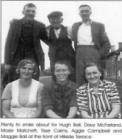 No matter how poor,
or how little there was the people in the village houses were
scrupulously clean. The quarry-tiled floor in the living room was washed
every day, the front-door step was scrubbed with vigour. Windows were
washed with water and vinegar, and the white curtains given the `dolly
blue' treatment. Most of the bedrooms had lino on the floor (think of
your warm feet getting out of bed in the middle of winter and walking on
this). No carpets, but maybe a rag rug as a luxury. Furniture was
sparse, but what you had was looked after, washed and polished (no spray
polish then, just wax and a lot of elbow grease). Walls were distempered
inside and whitewashed outside to keep the house bright and clean. Such
was the pride of the people of this village in their ability to keep up
appearances! No matter how poor,
or how little there was the people in the village houses were
scrupulously clean. The quarry-tiled floor in the living room was washed
every day, the front-door step was scrubbed with vigour. Windows were
washed with water and vinegar, and the white curtains given the `dolly
blue' treatment. Most of the bedrooms had lino on the floor (think of
your warm feet getting out of bed in the middle of winter and walking on
this). No carpets, but maybe a rag rug as a luxury. Furniture was
sparse, but what you had was looked after, washed and polished (no spray
polish then, just wax and a lot of elbow grease). Walls were distempered
inside and whitewashed outside to keep the house bright and clean. Such
was the pride of the people of this village in their ability to keep up
appearances! Life was hard in the days of the mill
workers. Money was scarce and clothes were in many cases hand made. If
someone grew out of an
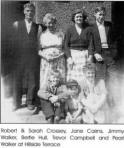 article of clothing it was passed on to the next
in the family, or in the case of adults cut down to fit a child in the
family. Most young boys wore short trousers, and this was because if the
knees of a long pair were worn out and beyond repair they were cut down
and adjusted to fit a younger member of the family. Shoes were the
hardest item to keep in supply in the family. If they didn't fit anyone
else the leather was cut out to accommodate the toes and thereby extend
their usefulness. One could only hope this happened in the summer and
not the winter! Woollen articles that had become worn were unpicked and
the usable wool unravelled and wound to be used again. Holes in socks
were a major problem and darning became an evening function for the
females of all households. All female members of the family learned to
knit, and mastered the complications of using four needles to knit socks
and turn a heel. Many a person learned the trick of covering up the
apparent hole in the heel of a sock by putting boot polish on their heel
as a disguise. The same can be said for the use of a collar and cuffs
and false bib front where no good white shirt was available. For many
men the suit they were married in was the one in which they were `laid
out' on death. article of clothing it was passed on to the next
in the family, or in the case of adults cut down to fit a child in the
family. Most young boys wore short trousers, and this was because if the
knees of a long pair were worn out and beyond repair they were cut down
and adjusted to fit a younger member of the family. Shoes were the
hardest item to keep in supply in the family. If they didn't fit anyone
else the leather was cut out to accommodate the toes and thereby extend
their usefulness. One could only hope this happened in the summer and
not the winter! Woollen articles that had become worn were unpicked and
the usable wool unravelled and wound to be used again. Holes in socks
were a major problem and darning became an evening function for the
females of all households. All female members of the family learned to
knit, and mastered the complications of using four needles to knit socks
and turn a heel. Many a person learned the trick of covering up the
apparent hole in the heel of a sock by putting boot polish on their heel
as a disguise. The same can be said for the use of a collar and cuffs
and false bib front where no good white shirt was available. For many
men the suit they were married in was the one in which they were `laid
out' on death. One plus factor of living in the village
was the availability of a plot of land (an allotment), or a garden
adjacent to the house. All the ground set in a square behind the mill
houses comprised the plots'. Here each household could grow vegetables,
keep chickens or pigs. Some of the `plots' were meticulously kept,
whilst others tended to contain all sorts of ramshackled home-made
constructions to house an assortment of livestock. Cabbage, leeks,
celery, parsley, carrots, parsnips, potatoes, cauliflower, brussel
sprouts, potatoes, lettuce and scallions were all produced for home
consumption, and these were the mainstay of the household diet. The odd
fruit bush thrived, if it was left alone by the local children who has a
penchant for gooseberries, raspberries and blackcurrants. A few people
grew flowers, but vegetables were more important to the household.
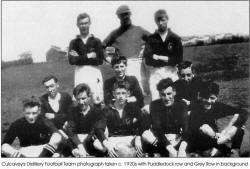 Leisure pursuits were of the inhabitants making. In the early days
skittles were played at the crossroads. Pitch and toss was popular.
Football, rounders and cricket were played in the field that stood
between the Mill and Smithy Row. The odd secret `card school' was held
in secluded places, and pigeon racing was very popular. No washing went
out on a Saturday when the pigeons were expected home from a race.
Groups of men stood along the back of the houses eyes eagerly scanning
the sky in the hope for an `early trap' and maybe a few shillings won.
Children played along the plots, making houses and dens in the
hedgerows, played hopscotch, Queenie-Queenie, marbles, conkers, guiders,
tig, hoops and various complicated ball games. Winter brought slides
made along the middle of the road on the various hills of the village �
no motor cars to worry about � and sledging in the fields up Harry's
Road. Leisure pursuits were of the inhabitants making. In the early days
skittles were played at the crossroads. Pitch and toss was popular.
Football, rounders and cricket were played in the field that stood
between the Mill and Smithy Row. The odd secret `card school' was held
in secluded places, and pigeon racing was very popular. No washing went
out on a Saturday when the pigeons were expected home from a race.
Groups of men stood along the back of the houses eyes eagerly scanning
the sky in the hope for an `early trap' and maybe a few shillings won.
Children played along the plots, making houses and dens in the
hedgerows, played hopscotch, Queenie-Queenie, marbles, conkers, guiders,
tig, hoops and various complicated ball games. Winter brought slides
made along the middle of the road on the various hills of the village �
no motor cars to worry about � and sledging in the fields up Harry's
Road.
Competitive football played an important part in village
life. In the early years the men named their team "Distillery", probably
after the brewery that first set up Culcavey village. Unfortunately
after World War Two the football team folded up. There were many good
football players from the next generation of young men and most of them
moved to the Hillsborough team, Downshire A.F.C. that is still going
strong today. Names of some the players were Alex White, Charlie Freel,
Tommy McCarthy, Billy Cargin, Dessie Russell, Tommy Whiteside, Tommy
Williamson, Bertie Cairns and Thompson Crossey. Bertie Cairns also
played for Glenavon while Thompson Crossey, having had trials with
Glenavon, played for Albert Foundry in the intermediate league. Some of
the later generation also played for Maze Rec.
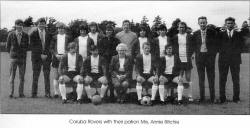 In the
1970s another team was formed playing under the name of Coruba Rovers.
Apparently the name `Coruba' was a brand of rum and the makers sponsored
the team. The team was formed in what always proved to be the favourite
bar for the Culcavey lads, Annie Ritchie's in Hillsborough. Although
based in Hillsborough it almost completely comprised Culcavey men. Their
patron was Mrs. Annie Ritchie and the team enjoyed a good few years in
competitive football. In the
1970s another team was formed playing under the name of Coruba Rovers.
Apparently the name `Coruba' was a brand of rum and the makers sponsored
the team. The team was formed in what always proved to be the favourite
bar for the Culcavey lads, Annie Ritchie's in Hillsborough. Although
based in Hillsborough it almost completely comprised Culcavey men. Their
patron was Mrs. Annie Ritchie and the team enjoyed a good few years in
competitive football. For many the `pictures' in
Ritchie's Hut in Hillsborough on a Monday night was a major event, and
the lucky ones had the shilling admission. Dances in the Orange Hall in
Hillsborough usually took place on a Saturday night, but occasionally a
Friday night was something of a treat. Many romances took place and
survived at a meeting there. Courting couples had only the lane ways and
byways to do their romancing, no cosy parlour to be on your own for a
couple of hours, just a meeting at the corner and a walk no matter what
the weather was like. Sunday saw the youth of the village taking walks
along the Canal tow path wearing their best clothes, and as the older
people would say `running their eye over each other'. A lot of the
socialising went on in the evenings at the corner of Hillside Terrace or
outside Emerson's Shop, where groups would meet, talk and share jokes.
If the local policeman happened to pedal by he was greeted with a
courteous `Good Evening, Sir'. The age of respect was then, instilled in
you at home and school.
Through the years the changes
came. The major ones were in the 1950's when running water and
electricity was installed in the houses. Such a luxury, not having to
run to the pump, but that
was only for the water. Still no bathroom or flush-toilet until the
1960's when the factory sold the houses to the local Council. Then came
the major event of at long last having a bathroom and a toilet.
Electricity changed life for the better, now people did away with the
range in the kitchen and installed a 'devon grate' (an open fireplace)
and electric cookers came into vogue. Television was an innovation, and
when one household in Hillside Terrace bought their first set, they were
inundated by a queue of young boys asking "Can we see the Lone Ranger,
please?". The hard work went out of the household when a washing machine
was purchased, and slowly an old way of life disappeared, replaced by
modernisation. Some things did remain unchanged, the Sunday School trip
organised by the Mission Hall was still a yearly highlight as was their
Christmas Party. On 11th July the bonfire was, and still is, lit to
celebrate `The Twelfth'. For years an Arch was put up near the
crossroads on 1st July as part of the celebrations. Our memories will
recall dancing at the bonfire, roasting potatoes, and singing, the
people celebrating their culture and tradition.
 Today,
standing like a sentinel, the old oak tree marking the start of the Mill
houses at Smithy Row maintains its vigilance over the village houses
starting at Ogles Terrace. It is ironic to think today that this Ulster
'linen' village changed hands for the princely sum of �2,250 when it was
sold to Hillsborough Rural Council. In April 1961 the list of tenants
reads:
|
Smithy Row: |
|
No.l Mary M. Dodds |
|
No.2 Vacant |
|
English Row:
|
|
No.l Alfred C Armstrong |
|
No.2 William S Bowman |
|
No.3 Adelaide Irvine |
|
No.4 James McAnally |
|
No.5 Jeannie Bowman |
|
No.6 Vacant |
|
No.7 Norman Chapman |
|
No.8 Thomas Gordon |
|
Shop Row: |
|
No.l Phyllis G Briggs |
|
No.2 Margaret L Hanna |
|
No.3 Elizabeth Pollock |
|
No.4 Diana Harrison |
|
White Row (Hillside Terrace)
|
| No.1 Agnes Campbell |
|
No.2 Ena Hewitt |
|
No.3 Frederick Hull |
|
No.4 Sarah Ringland |
|
No.5 Kathleen Crothers |
|
No.6 Martha Ann Ruddy |
|
No.7 Margaret Ball |
| No.8 Margaret E. Matchett |
|
|
No.9 Margaret Bell |
|
No.10 Letitia Cairns
|
|
No.l l Elizabeth Prince
|
|
No.12 Florence Kane
|
|
No.l3 Jane Cairns
|
|
No.14 Robert Crossey
|
|
No.l5 Stewart Walker
|
|
No.16 Margaret Mercer |
|
Thompson's Row |
|
No.l Sarah Cairns |
|
No.2 Susan McCaugherty |
|
No.3 May Acheson |
|
No.4 Eileen Nicholson |
|
No.5 Florence Crothers |
|
No.6 Robert Cairns |
|
No.7 David Kerr |
|
No.8 Sarah McCambley |
|
No.9 Sarah E. Hewitt |
|
No.10 Renee Crossey |
|
Puddledock Row:
|
|
No.l Robert Molloy |
|
No.2 Wm. John Hull |
|
No.3 Leonora Gamble |
|
No.4 Leonard Magee |
|
No.5 William Spratt |
|
No.6 Edward Greenfield
|
|
Much may have disappeared, but the village still retains plenty of the
character of the people. For here today we have a generation of people
whose relatives were the `Mill people'. Some of the names may have
changed by marriage, but they can quote grandparents and great
grandparents who worked and lived in the area. Names like Kane, Ringland,
Hewitt, Cairns, Crossey, Hull, McQuillan, Walker, Matchett, Ball,
Chapman to name but a few.

THE WHISKEY RIVER
The Whiskey River meanders from the Mill Pond, through what was once the
glen, down round the area where the Linen Mill originally stood. Its
course meanders down the back of houses at Grove Park (originally a
green-field area). It passes under what is called the Whiskey Bridge on
the Aughnatrick Road (originally called Puddledock Road) and makes its
way through the fields right down to the River Lagan. The name of the
river originated from the days of the Distillery. Apparently whiskey was
disposed of by washing it down the river to avoid an explanation to the
Customs men as to the storage of more whiskey than the records showed,
and it is amazing to think that its title has remained unchanged in a
very transient world. All around it the names of houses, roads and
townlands have changed, but it has endured and if it could talk it could
tell a tale all of its own. CULCAVEY STORES
Today's visitor to Culcavey Stores might think that this is a building
of recent construction, but it has, in fact, quite a long history.
Culcavey Stores was built after the Hillsborough Linen Company was
formed. The front doors of the shop faced north, and there was a yard
outside with stables and stores. Living accommodation was on the first
floor. When Mr Shaw, the original shopkeeper died in 1893
his wife emigrated to New Zealand. He operated a `co-op shop', i.e. each
week he worked three days in the factory and three days in the shop. The
Emerson family who lived in number 2 Distillery Row (re-named White Row)
and sold some perishable food from there, were given the tenancy of the
stores. There was no co-op arrangement, so they were on their own.
All produce was delivered in bulk and weighed and wrapped according to
demand. In those days a housewife would often carry purchases home in
her apron. Staple foods like tea, sugar, butter, bacon, eggs and flour
were the main items sold. During the war food was rationed and records
of purchases and sales had to be kept. The rationed food presented no
problem. It was however necessary to ensure that unrationed items were
fairly distributed. The quantity of bulk supplies received was based on
previous purchases. Food coupons were returned each month to the Food
Office in Lisburn. After 1945 the change from bulk
supplies to pre-packaging began to gather pace, and as time went on
supermarkets and television advertising changed the food trade. Aids
such as cash registers and refrigerators altered the layout of shops.
This momentum continues.
Bertie Emerson retired in 1991. So like distilling and linen weaving
carried on at Culcavey Factory, the Emerson family, who had run the
grocery business at Culcavey for more than one hundred years, ceased
trading. However, the shop still exists under different management and
continues to be an integral part of life in the area.
During the 1939-43 War the following was an advertisement in the
Dromore Leader, composed by the proprietor, Mr RJ Emerson:
Our customers on wash day
Should never dread "the tub".
With lots of soap and powders
They have never hard to rub. They wisely decided
When they talked the matter o'er.
To get all their wants provided
They must ration at The Store. YES, we have
THE GOODS! GEO. EMERSON & SON
Select Grocers
Culcavey Stores (near Hillsborough)
 |